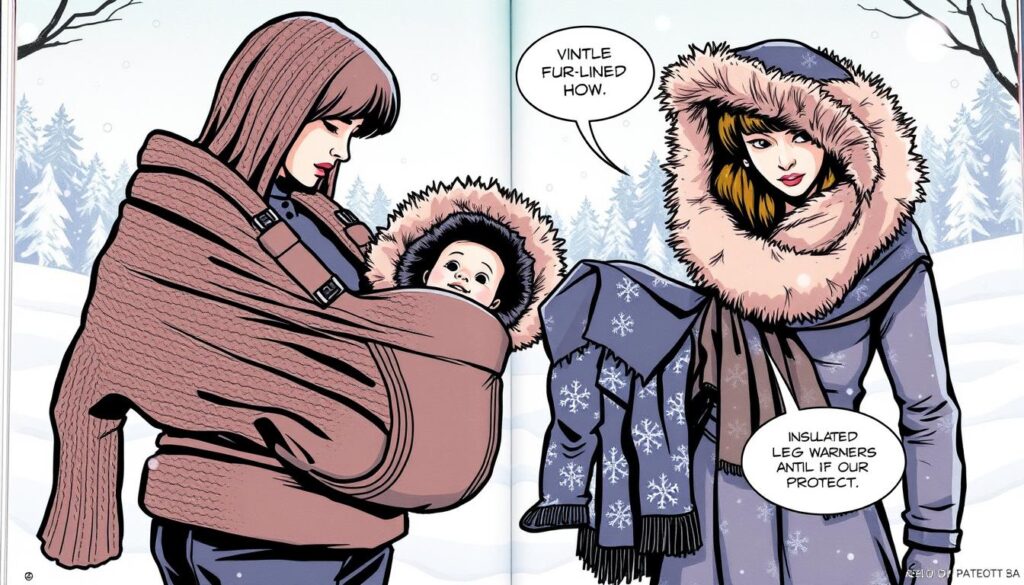Best Babywearing Gear for Winter
Did you know that over 70% of new parents in the United States choose to use baby carriers to keep their little ones close during the chilly winter months? Babywearing offers a convenient and cozy way to explore the outdoors with your bundle of joy while keeping them snug and secure. However, navigating the world of winter babywearing can be a daunting task, as the right gear is essential to ensure the safety and comfort of both parent and child.
In this comprehensive guide, we’ll explore the must-have babywearing gear and essential safety considerations to keep you and your baby warm, dry, and comfortable during the colder seasons. From insulated carrier covers and weather-resistant fabrics to layering techniques and temperature monitoring, you’ll learn everything you need to know to make the most of your winter babywearing adventures.
Key Takeaways
- Proper winter babywearing gear is essential for keeping both parent and baby comfortable and safe in cold weather
- Essential items include insulated carrier covers, weather-resistant carriers, and layered clothing options
- Knowing how to monitor baby’s temperature and adjust layers throughout the day is crucial for winter babywearing
- Specialized babywearing coats and jackets can provide an extra layer of protection against wind, rain, and snow
- Choosing the right base layers made from moisture-wicking and thermal fabrics can help regulate body temperature
Understanding Winter Babywearing Safety Essentials
Keeping your little one warm and cozy while babywearing in the winter is a priority, but it’s equally crucial to ensure their safety. By following a few simple guidelines, you can maintain the perfect temperature balance and protect your baby from the elements.
Temperature Monitoring Guidelines
Regularly check your baby’s neck and back to monitor their temperature. The skin should feel warm but not overly hot. If your baby’s neck or back feels cool, it’s time to add an extra layer. Use the “plus one” rule: dress your baby in one more layer than you’re wearing to maintain the right temperature.
Safe Layering Techniques
- Start with a breathable, moisture-wicking base layer
- Add an insulating mid-layer, such as a sweater or fleece
- Top with a weatherproof outer layer to block wind and moisture
- Don’t over-bundle your baby, as this can lead to overheating
Weather Protection Basics
Protect your baby from wind and precipitation with a water-resistant outer layer, such as a rain cover or babywearing jacket. Ensure proper airflow around your baby’s face to prevent overheating. Consider using a carrier with built-in weather shields or attachments to help shield your little one from the elements.
By following these winter babywearing safety essentials, you can keep your baby warm, comfortable, and protected while enjoying the cozy comfort of close-contact carrying.
Specialized Babywearing Winter Coats and Jackets
As the colder months approach, specialized babywearing coats and jackets become essential for keeping both parent and baby warm and protected during outdoor adventures. These garments are designed with expandable panels that accommodate a baby carrier, ensuring comfortable and cozy outings even in the harshest winter conditions.
One popular option is the Mamajacket, a versatile 3-in-1 jacket that seamlessly integrates with a baby carrier. This innovative design allows you to wear your baby close to your body while staying warm and shielded from the elements. Similarly, the Seraphine 3-in-1 Maternity Jacket offers a comfortable and practical solution, with a detachable babywearing insert that can be worn independently or zipped into the main jacket.
Another standout choice is the Kokoala Coat Extension, a clever accessory that transforms your existing coat into a babywearing-friendly garment. By attaching the Kokoala Extension, you can extend the coverage of your coat to encompass your baby, creating a cozy and protected environment for both of you.
| Product | Price | Carrying Positions |
|---|---|---|
| Mamajacket | Varies | Front-facing parent, front-facing out |
| Seraphine 3-in-1 Maternity Jacket | Varies | Front-facing parent, front-facing out |
| Kokoala Coat Extension | Varies | Front-facing parent, front-facing out |
These specialized babywearing coats and jackets provide the perfect blend of warmth, weather protection, and practical functionality, ensuring you and your little one can venture out into the winter wonderland with ease and comfort.
Essential Base Layer Options for Parent and Baby
When it comes to babywearing layers for winter, the base layer is crucial for regulating body temperature and providing essential insulation. Whether you’re the parent or the little one strapped in, the right base layer can make all the difference in keeping you both comfortable and warm.
Moisture-Wicking Materials
Look for base layers made from fabrics that excel at moisture-wicking. Merino wool and synthetic blends are excellent choices, as they efficiently draw moisture away from the skin, preventing chill and discomfort. Avoid cotton, which can become heavy and damp when exposed to sweat or precipitation.
Thermal Underlayers
Thermal babywearing insulation is essential for trapping heat and maintaining core body temperature. Opt for lightweight, breathable options like polyester or polypropylene that won’t add unwanted bulk. For babies, consider soft, insulating fabrics like bamboo or lightweight merino wool.
Comfortable Fabric Choices
When it comes to babywearing layers, comfort is key. Choose fabrics that are soft, flexible, and won’t chafe or irritate delicate skin. Natural fibers like cotton or bamboo are excellent options for babies, providing breathability and a gentle touch.

Remember, the goal is to keep you and your little one warm and cozy without overheating. Avoid overdressing, as it can lead to excessive sweating and discomfort. By selecting the right base layer materials, you’ll be well on your way to a comfortable, safe, and enjoyable winter babywearing experience.
Staying Warm While Babywearing: Complete Guide
Staying warm while babywearing during the winter months is essential for both you and your little one. The key is to layer up with the right clothing and accessories to keep the cold at bay. Start with a moisture-wicking base layer that will keep you and your baby dry. Add insulating mid-layers, such as fleece or wool, to trap heat. Top it off with a weather-resistant outer layer, like a babywearing coat or cover, to shield against wind and precipitation.
Don’t forget to protect your extremities too. Wear a warm hat, gloves or mittens, and thick socks to keep your hands, head, and feet cozy. Monitor your and your baby’s temperature frequently, and adjust the layers as needed to maintain optimal comfort throughout your outing.
- Staying warm while babywearing is crucial for both you and your little one during the winter months.
- Start with a moisture-wicking base layer, add insulating mid-layers, and top with a weather-resistant outer layer.
- Protect your extremities with a warm hat, gloves or mittens, and thick socks.
- Monitor your and your baby’s temperature regularly, and adjust layers as needed.
By following these babywearing cold weather tips, you can stay comfortable and enjoy your winter outings with your little one securely snuggled close to you.
Winter-Specific Baby Carriers and Wraps
When it comes to babywearing in winter, having the right carrier or wrap can make all the difference in keeping your little one warm and cozy. From weather-resistant carriers to insulated wrap options, there are several winter-specific choices that can help you brave the colder months with ease.
Weather-Resistant Carriers
Carriers like the Ergobaby Winter Weather Cover and LÍLLÉbaby All Seasons carrier offer built-in weather protection, featuring water-resistant outer shells and warm, fleece-lined interiors. These carriers are designed to shield your baby from wind, rain, and snow, ensuring they stay comfortable and dry during your winter outings.
Insulated Wrap Options
For a more versatile babywearing accessory, consider an insulated wrap like the Boba Wrap or Moby Wrap. These cozy options provide an extra layer of warmth, while still allowing for the close, snug fit that wraps are known for. The insulation helps trap heat, keeping both you and your baby warm throughout your winter adventures.
Carrier Weather Shields
Carrier weather shields, such as the 7 A.M. Enfant Pookie Poncho, offer an additional layer of protection for your baby. These universal covers can be used with a variety of carriers, strollers, and car seats, providing an extra barrier against wind, snow, and cold temperatures. With features like adjustable hoods and self-storing designs, these accessories make winter babywearing a breeze.
By incorporating these winter-specific babywearing options into your arsenal, you can ensure your little one stays warm and comfortable, no matter how chilly the weather may be. With the right gear, you can continue to enjoy the benefits of babywearing in winter throughout the colder months.
Protective Accessories for Winter Babywearing
When venturing out in the colder months, having the right babywearing accessories can make all the difference in keeping your little one snug and comfortable. From warm hats and mittens to carrier covers and weather shields, these essential items are crucial for babywearing accessories and keeping baby warm while babywearing.
Start with a cozy hat that covers the ears and neck to protect your baby’s delicate skin from the harsh winter elements. Pair it with soft, insulated mittens or booties to keep their hands and feet toasty warm. For added warmth, consider a fleece-lined carrier cover or a universal weather shield that can attach directly to your baby carrier.
Neck warmers and ear muffs are also great babywearing accessories for both you and your baby, providing an extra layer of protection against the cold. If you’re wearing your baby in a front carry position, don’t forget about leg warmers to keep their little legs cozy and comfortable.
| Accessory | Key Features | Recommended Products |
|---|---|---|
| Hats | Covers ears and neck, insulated fabric | Patagonia Baby Snow Pile Hat, Reima Blomma Beanie |
| Mittens/Booties | Warm, moisture-wicking materials | Stonz Mittens, Melton Merino Wool Booties |
| Carrier Covers | Fleece-lined, weather-resistant | Baby K’tan Carrier Cover, Moby Wrap Weather Shield |
| Neck Warmers/Ear Muffs | Extra insulation for parent and baby | Turtle Fur Neck Warmer, JXTH Ear Muffs |
| Leg Warmers | Keep legs cozy in front carry position | Go Gently Nation Leg Warmers, Chooze Leg Warmers |
By investing in these babywearing accessories, you can ensure your little one stays warm and comfortable while you tackle the winter weather together. With the right gear, keeping baby warm while babywearing becomes a breeze.

Temperature Regulation Tips and Techniques
Keeping your little one comfortable and safe during winter babywearing is all about effective temperature regulation. By mastering a few key techniques, you can ensure your baby stays cozy without overheating or getting too cold.
Monitoring Baby’s Temperature
Regularly check your baby’s temperature by gently feeling the back of their neck and their chest. If their skin feels warm and slightly sweaty, it’s a sign that they may be too hot and need to remove a layer. On the other hand, if their skin feels cool to the touch, it’s time to add an extra layer to keep them warm.
Adjusting Layers Throughout the Day
Remember, your baby’s temperature can fluctuate throughout the day, depending on their activity level, the weather, and other factors. Be prepared to adjust their layers as needed. Opt for zip-up or snap-up clothing, which makes it easy to add or remove layers without disturbing your baby. This way, you can ensure they stay cozy and comfortable, no matter the conditions.
By staying vigilant and making timely adjustments, you can help your little one maintain the perfect babywearing temperature regulation and enjoy your winter outings stress-free. With these babywearing cold weather tips, you’ll be well on your way to keeping your baby warm, safe, and happy all season long.
Weather-Specific Babywearing Strategies
As the temperatures drop and the weather becomes more unpredictable, it’s crucial to have the right babywearing strategies in place to keep you and your little one warm and comfortable. Whether you’re dealing with snowy conditions, blustery winds, or heavy rain, there are specialized techniques and gear that can help you navigate the winter months with ease.
Conquering Snowy Conditions
For snowy weather, invest in a weather shield or a babywearing coat designed to protect you and your baby from moisture. These specialized covers can be easily attached to your carrier, creating a barrier against the elements while still allowing airflow and visibility.
Battling Blustery Winds
In windy conditions, position your baby facing inwards, close to your body, and use a wind-resistant outer layer to shield them from the gusts. These could include specialized babywearing jackets or wraps that provide an extra layer of protection.
Navigating Rainy Days
For rainy days, opt for waterproof carriers or covers that will keep your little one dry. Some carriers even come with built-in rain hoods or shields, making it easy to stay protected from the downpour.
Facing Extreme Cold
In extreme cold, it’s best to limit outdoor time and use insulated gear designed for arctic conditions. Look for carriers and wraps that feature thermal lining, windproof fabrics, and ample insulation to keep your baby warm and cozy.
By being prepared with the right babywearing in winter and babywearing cold weather tips, you can conquer any winter weather and continue to enjoy the benefits of babywearing throughout the colder months.
Conclusion
Staying warm while babywearing in the winter requires careful preparation and a thorough understanding of essential safety guidelines. By investing in the right winter babywearing gear, mastering layering techniques, and implementing effective temperature regulation strategies, parents can ensure their little ones stay cozy and comfortable during outdoor adventures.
From specialized winter coats and jackets to insulated wraps and weather-resistant carriers, the key is to create a layered system that shields both parent and baby from the elements. Additionally, monitoring baby’s temperature, adjusting layers as needed, and employing protective accessories like hats and mittens can help maintain the perfect balance of warmth.
With the right knowledge and equipment, families can confidently embrace the joys of winter babywearing, fostering a close bond while exploring the great outdoors. By staying informed and prepared, parents can ensure a safe and comfortable experience for themselves and their little ones, paving the way for memorable winter adventures.







